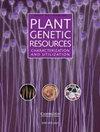利用农业形态和DArTseq标记揭示班巴拉花生的遗传变异,并通过选择提高产量
IF 0.7
4区 生物学
Q3 PLANT SCIENCES
Plant Genetic Resources: Characterization and Utilization
Pub Date : 2023-08-01
DOI:10.1017/s1479262123000503
引用次数: 0
摘要
班巴拉花生(Vigna subterrea)在品种选择和开发方面被忽视了,这导致农民种植的是没有遗传特征和低产的地方品种的混合物。由于需要在马拉维建立一个育种方案,有必要彻底了解现有种质中存在的遗传多样性。本研究的目的是利用农业形态性状和SNP标记对班巴拉基因型GD进行鉴定,并鉴定和选择高产班巴拉基因型。实地试验在本达学院进行了两个季节。随后,使用DartSeqLD SNP标记对基因型进行基因分型。所有数据均使用R软件包进行分析。在包括籽粒产量在内的大多数性状上观察到显著的遗传变异(P < 0.001),这表明班巴拉花生存在遗传变异,可以在旨在开发高性能品种的育种计划中加以利用。基于粮食产量,该研究确定了18个在整个评估季节表现最好的基因型,这些基因型将在农民的田间条件下进行测试。DArTseqLD将基因型分为三个簇。我们注意到大多数来自同一来源的基因型聚集在一起。在南部非洲和西非地区的基因型之间观察到较高的遗传距离,这对班巴拉遗传改良的亲本选择具有重要意义。我们的研究结果为班巴拉花生遗传变异的程度以及如何选择亲本系以提高遗传增益提供了有价值的见解。本文章由计算机程序翻译,如有差异,请以英文原文为准。
Genetic variation in Bambara ground nuts as revealed by agro-morphological and DArTseq markers and selection for improved yield performance
Bambara groundnut (Vigna subterranea (L.) Verdc) has been neglected in terms of variety selection and development which has resulted in farmers growing a mixture of landraces that are not genetically characterized and are low yielding. With the need to set up a breeding programme in Malawi, it was necessary to thoroughly understand the genetic diversity (GD) present in the available germplasm. The objectives of the study were to assess Bambara genotypes GD using agro-morphological traits and SNP markers, and to identify and select high yielding Bambara genotypes. Field trials were conducted for two seasons at Bunda College. Later, genotypes were genotyped using DartSeqLD SNP markers. All data were analysed using R Package. Significant genetic variations (P < 0.001) were observed for most traits including grain yield, which suggests that genetic variability exists in Bambara groundnuts which can be exploited in breeding programmes aimed at developing high performing varieties. Based on grain yield, the study identified 18 top performing genotypes across the evaluation seasons which will be tested under farmers’ fields’ conditions. DArTseqLD grouped the genotypes into three clusters. It was noted that majority of the genotypes from the same origin clustered together. High genetic distances were observed between genotypes from Southern African and West African regions and this has important implications in parental selection for the genetic improvement of Bambara. Our results provide valuable insights about the extent of genetic variability and how parental lines can be selected for improved genetic gain in Bambara groundnuts.
求助全文
通过发布文献求助,成功后即可免费获取论文全文。
去求助
来源期刊

Plant Genetic Resources: Characterization and Utilization
Agricultural and Biological Sciences-Agronomy and Crop Science
CiteScore
2.80
自引率
0.00%
发文量
29
审稿时长
>12 weeks
期刊介绍:
Plant Genetic Resources is an international journal which provides a forum for describing the application of novel genomic technologies, as well as their integration with established techniques, towards the understanding of the genetic variation captured in both in situ and ex situ collections of crop and non-crop plants; and for the airing of wider issues relevant to plant germplasm conservation and utilisation. We particularly welcome multi-disciplinary approaches that incorporate both a technical and a socio-economic focus. Technical aspects can cover developments in technologies of potential or demonstrated relevance to the analysis of variation and diversity at the phenotypic and genotypic levels.
 求助内容:
求助内容: 应助结果提醒方式:
应助结果提醒方式:


